- Title: A Periodically Varying Luminous Quasar at z=2 from the Pan-STARRS1 Medium Deep Survey: A Candidate Supermassive Black Hole Binary in the Gravitational Wave-Driven Regime
- Authors: Tingting Liu et al.
- Authors’ Institutes: U Maryland, U Hawaii, GMTO Corp
- Publication Status: published in Astrophysical Journal Letters
If we read the light curve (its brightness versus time) of a quasar (that is, a supermassive black hole with a jet) like an electrocardiogram, we’d conclude that lots of quasars are having heart attacks. Their signals vary in brightness randomly, like the beats of an arrhythmic heart. The randomness of their emission may be related to their central supermassive black holes, which are surrounded by blobs of gas, dust, and stars, accreting onto the black hole at irregular intervals. The astronomers of today’s paper, however, found a quasar with a regular heartbeat. Quasar PSO J334.2028+01.4075 has a very healthy heart rate of 6.7 beats per decade, or once every 542 days. One explanation is that this guy hosts a pair of supermassive black holes. If true, then the astonishing interpretation of this quasar’s heart rate is that its black holes are only a few orbits away from merging! How did they catch their patient at such a critical stage?

Figure 1. Surface brightness of an accretion disk surrounding a supermassive black hole binary from a simulation by Farris et al. 2014. Notice the variations induced by the black hole orbits.
In fact, Liu et al. didn’t just stumble upon this quasar. They went looking for it. Here was their train of reasoning: Deep surveys reveal lots of galaxies merging long ago. After a galactic merger, the two central black holes (every big galaxy has one) will migrate to the new galaxy’s center, begin to orbit closely, and drive periodic accretion. Recent simulations reveal that a quasar periodically accreting like this could be visible as a sinusoidally-varying light curve. You can see waves of matter accreting onto the binary black hole in one such simulation in Fig. 1.
If the binary is very near the end of its life, when gravitational radiation begins to drive its rate of inspiral, its orbital period will be of the order of years (that is, for billion-solar-mass black holes—a binary’s inspiral timescale increases linearly with its total mass). In fact, several candidate supermassive black hole binaries have already been identified, for example as two bright spots in the center of a quasar. But these black holes are separated by thousands of parsecs, perhaps not even gravitationally bound to one another. Liu et al. were searching for a pair of supermassive black holes headed doggedly toward merger, not flirting at thousands of parsecs. So they rolled up their sleeves and dug through a multi-year survey of a small patch of sky, looking for a quasar with a light curve rising and falling once every few years.
Liu et al. belong to the Pan-STARRS collaboration, involved in rapid optical surveys of much of the sky since 2010, looking for things that flicker and blink. To fulfill one of their projects, the Medium Deep Survey, they observed ten patches of sky daily in five different colors. If you’re looking for quasars with light curves that oscillate on a timescale of years, this is the perfect data set to chew on.
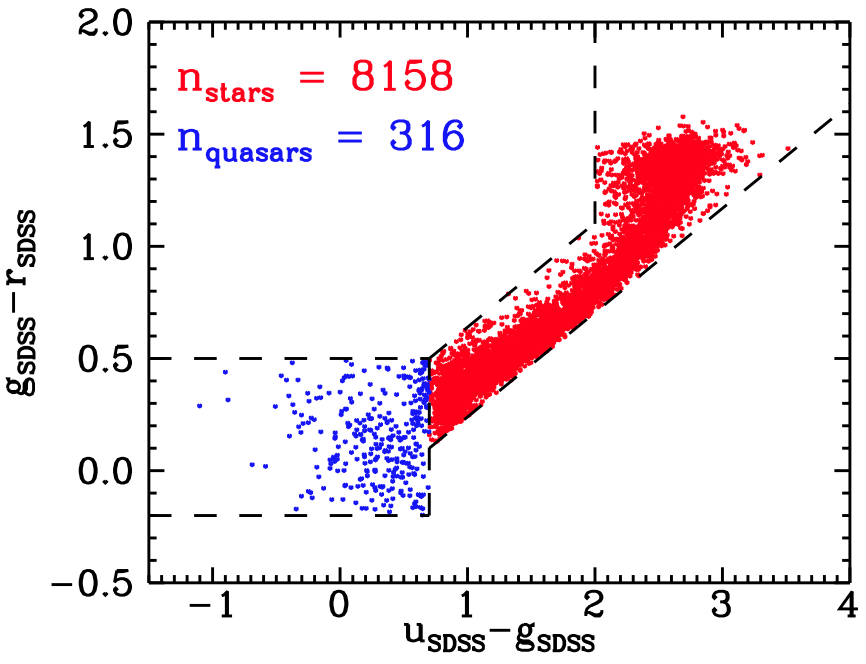
Figure 2. Color-color diagram of all the point sources in the field of view. A relative color-magnitude scale is given on each axis, defined for any given point by subtracting its brightness in one color filter from its brightness in some other color filter (more negative means brighter). The horizontal-axis is “ultraviolet-ness”, and the vertical-axis is “green-ness”. Thus objects with relatively more light at high energies (like quasars) are clustered in the bottom left.
The color data were helpful in gleaning a subset of potential quasars from all the bright dots in their field of view. The astronomers particularly wanted to avoid misidentifying a variable star (like an RR Lyrae) as a periodically-varying quasar. At optical wavelengths, quasars actually look a lot like stars, which is how they earned their name. But they are relatively brighter at shorter wavelengths than stars are. Liu et al. used a color-color filter, represented in Fig. 2, to select 316 candidate quasars.
Then they identified a subset of 168 quasars with large variations in brightness over the four years of data. Since they were on the hunt for periodic variations, they ran a Fourier analysis separately on each color channel of these light curves, looking for sinusoidal variations. They found 40 quasars with regular heartbeats visible in two or more color channels. Because the baseline of their observation was only four years, their search was only sensitive to periods less than that. In this paper, they present their most significant detection, PSO J334.2028+01.4075. Lightcurves for this quasar in each of four color channels are shown in Fig. 3, folded over the 542 day period.
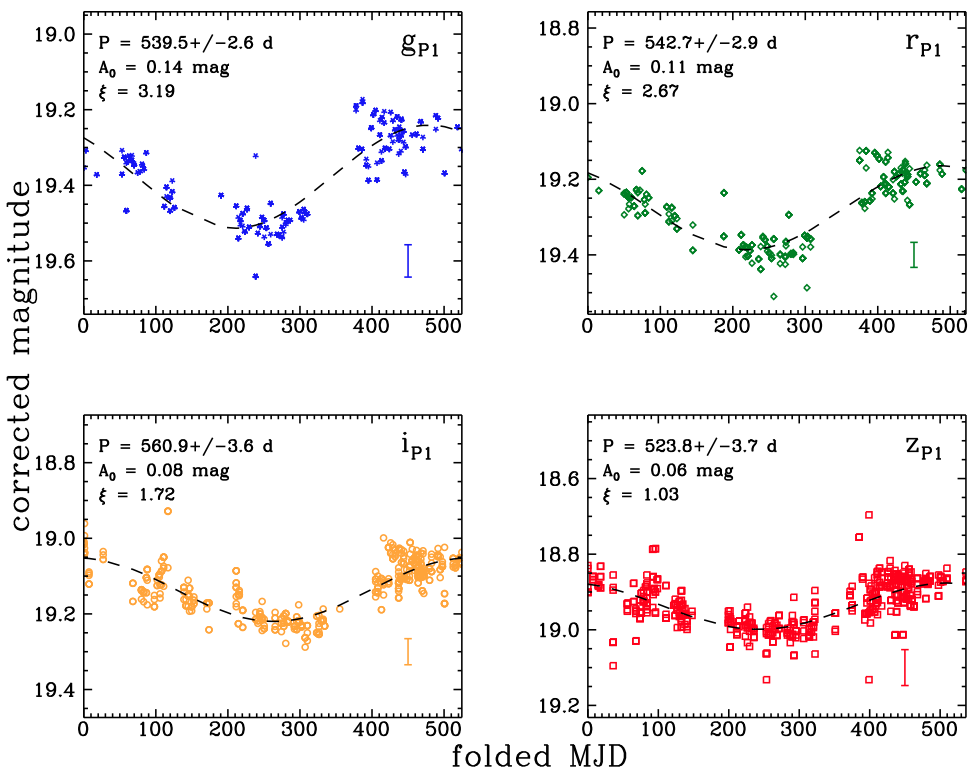
Figure 3. The brightness measurements of this quasar in each of the four observation bands. The best-fit sinusoid is overlayed as a dashed line.
Assuming the virial relationship between quasar spectral properties and black hole mass hold in this weird case with two black holes at the center, Liu et al. inferred that the total mass of the black holes is 10 billion solar masses. Then, identifying the period of the lightcurve with the orbital period of the binary, they calculated a black hole separation of 3-13 milliparsecs, or just 10 or so widths of the central black holes! If their interpretation of the light curve is correct, these central black holes are well on their way to merger, with only a handful of orbits left before that cataclysmic event.
The authors make sure to point out that there are other explanations. A single black hole could present a precessing jet, a little like a pulsar, which wobbles more or less in and out of view. But jet precessions usually occur on timescales of hundreds to millions of years. They also highlight a discovery announced in Nature only months before their own, of a similar periodically-varying quasar, with a period of five years. That supermassive black hole binary candidate, however, is lower-mass and nowhere near merger yet. That group also proposes alternative explanations, including hotspots in the accretion disk, or a precessing disk, but none are as simple as the supermassive binary black hole explanation.
Liu et al’s diagnosis of PSO J334.2028+01.4075 will be proven true or false within the decade. Alternatively, a more nuanced understanding of accretion onto binary black holes may contribute to a modified diagnosis. (“I’m terribly sorry about this, but we seem to have made an error. It appears you’ve got another billion years, PSO J334.2028+01.4075.”) But even at this early stage of discovery, Liu et al. have introduced an exciting new technique into time-domain extragalactic astronomy. Similar searches will easily be performed on larger surveys like those of the Large Synoptic Survey Telescope, uncovering thousands more periodic quasars, any one of them a potential host to a supermassive black hole binary on the verge of merger.

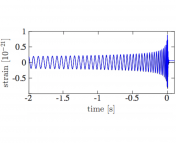
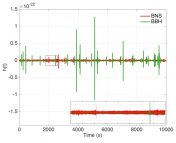
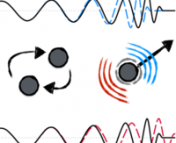
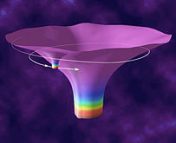
It’s interesting how a merger would lead to such a stable “heart beat” you’d think the chaotic nature of two black holes interacting would in of itself lead to peculiar emissions.
It is strange. But even though the changes in their orbits are accelerating—getting faster and faster, closer and closer—the changes are happening very smoothly.
But I don’t think astrophysicists have come close to exploring all the possibilities of what the light might look like from accretion onto a merging black hole binary. Computational explorations of this problem have only been possible for about a decade. And current simulations make a number of simplifying assumptions. That’s why this chance to (maybe) watch an accreting merger in the act is especially exciting.
What a cool study! It’s neat that we will be able to see fairly soon if they were right. What happens when two SMBHs merge, and what will we be able to observe? Have we ever seen a galaxy before and after a merger before? It seems like it wouldn’t have been possible before this. Very exciting
At what point do we observe a difference between the irregular “heartbeat” of an individual quasar and the regular “heartbeat” of the merger of two black holes? Is it as soon as accretion begins?
How rare are such events? Is it simply a matter of looking far enough away? (it would be cool if it could be demonstrated that black hole mergers consistently produce regular emissions!)
How sure are we this isn’t just a small sample size fluke – if we’ve only observed regular emission a couple times, what makes us sure the beat is really regular?
Have we ever observed a merger? Based on this it appears we have not, but it is interesting to consider what this “cataclysmic event” would look like.
What makes the hotspots on the accretion disk and precessing disk theories so much less simple than the supermassive binary black hole explanation?
Interesting. I wonder if the power spectrum is significantly different in this case over a range of frequencies? Or is it just spiked at the “heartbeat” frequency quoted above?
The data visualization in the first figure is really impressive. There seems to be a trend in astronomy of moving toward flashier images as technology improves.